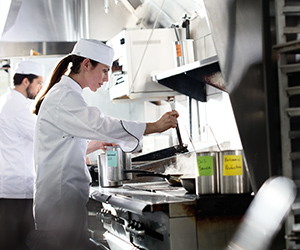Five Steps to Optimizing Restaurant Operations
4 Min Read By 3M
Maximizing productivity in your commercial kitchen can mean a restaurant that is more efficient, saves money and attracts return customers. Improving workplace performance is critical – and not as hard as you might think.
Down time is dead time. The wrong equipment, a lack of on-hand supplies, inefficient systems, poorly trained staff and bad communication … all or any one of these can dramatically slow your operation down, costing you customers and revenue.
In a service business nearly entirely reliant on customer experience, a single loss of efficiency has a true ripple effect.
In a service business nearly entirely reliant on customer experience, a single loss of efficiency has a true ripple effect. While maximum productivity is a key concern for any business, it’s absolutely critical for restaurant owners. In a service business nearly entirely reliant on customer experience, a single loss of efficiency has a true ripple effect. Throughout the kitchen and restaurant, success lies in helping employees be efficient in their work, providing them with the right tools and covering a range of related bases geared to delivering on your brand promise.
“[Your restaurant] should be a well-oiled machine,” says former restaurant worker Laura MacLeod, founder of From the Inside Out, a consultancy that helps businesses facilitate communication and productivity. Because average operating costs for a restaurant can improve with increased efficiency, you need to be vigilant. These five kitchen manager tips can help you optimize your restaurant’s operations and get more done.
Step One: Use the Right Tools for Kitchen Operations Tasks
Using the wrong equipment or worn-out tools can cause big issues for your restaurant. If equipment like cooking tools or headsets breaks or is difficult to use, employees may waste time and become frustrated. Using the wrong tool may unintentionally cause injury and possibly leave the restaurant open to legal risk. In addition, using caustic or inefficient cleaning supplies can take extra time and be uncomfortable for employees.
“You must consider the cost of workers’ time,” says Carolina Bautista-Brown, marketing manager, food supply business, at 3M. If you’re using cleaning solutions or hand pads that don’t remove grease well or that cause workers to take longer to clean the griddle or finish proper floor care at the end of the night, you’re not only frustrating your staff, you’re adding to your payroll costs, she says. Invest in efficient supplies that help your employees do their jobs well. This can also lead to decreased turnover and happy employees that better interact with customers. In a tight labor market, that’s an important consideration.

Step Two: Take Stock of Your Commercial Kitchen
Sometimes, simply being out of stock of a product or supply can derail efficiency and lose customers. MacLeod notes that it may be as simple as running out of to-go coffee cups. Think about the time that staff spend running around looking for supplies, only to find out that inventory has run out and the restaurant can’t sell the food or beverage as planned. Not only do you waste time, but you lose a sale—and possible future orders from that customer, she says.
Also, consider investing in durable products that last longer, Bautista-Brown says. Products like scouring pads can be reused more frequently, reducing waste and replacement costs. They also take less space to store and are less likely to break down, risking food contamination.
Step Three: Create Systems for Restocking Kitchen Products
Create systems to ensure that the ingredients, supplies and other goods you need to run your restaurant are always on hand, says Bautista-Brown. Establish clear re-order levels based on the time it takes suppliers to replenish what you need. Consider creating a list of items that should be checked and a system of follow-through to be sure that orders are made in a timely fashion and assign responsibility to a staff member to oversee these inventory checks.
Throughout the kitchen and restaurant, success lies in helping employees be efficient in their work, providing them with the right tools and covering a range of related bases geared to delivering on your brand promise.
Systems can increase efficiency in virtually every area of your restaurant. Creating systems for seating, taking reservations, handling customer complaints and other tasks can help you streamline them and ensure that, no matter who is handling the issue, customers can expect a consistent experience, MacLeod says.
Step Four: Thoroughly Train Restaurant Employees
In many restaurants, training is done in a casual manner, asserts MacLeod. A new server may shadow an experienced one for a few days or a week, and then they’re set off on their own. But even an experienced server may forget to train the new employee in all of the restaurant’s systems or practices. A thorough training approach can also help with engaging millennial employees.
This is where a training manual or, at least, a checklist is useful. By documenting the areas in which a server needs to be trained, the restaurant can ensure that the new person is made aware of all existing practices and policies that make up the brand experience. As customers increasingly demand to be delighted by their visit, this comprehensive approach can be invaluable, she says.
Step Five: Keep Communication Open
If you make changes, choose new equipment or supplies, discontinue menu items or change policies, communication with your staff is essential, MacLeod says. Making changes without alerting employees can make them feel less engaged and affect their interactions with customers. Conversely, keeping lines of communication open can lead to breakthrough ideas and better ways of doing things.
Kitchen manager duties and responsibilities are varied and demanding. Improving productivity bolsters your restaurant’s customer experience and its bottom line. Be sure to make the right moves to support your employees and watch their efficiency and engagement soar.
For additional information on this topic and more, click here.


